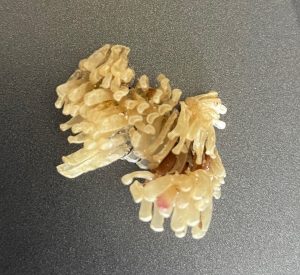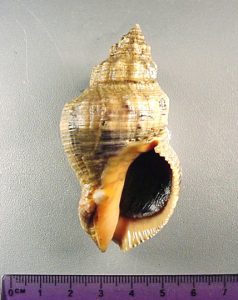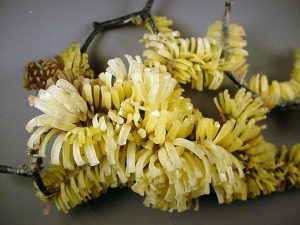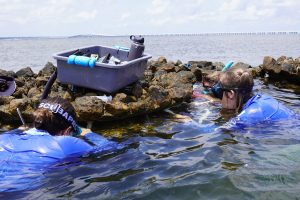
Last week, I took a group of kids on a beach walk at Deadman’s Island in Gulf Breeze. They picked up hermit crabs, watched shorebirds, and looked for interesting finds along the beach. Toward the east end of the peninsula (it’s not actually an island anymore), there are oyster-covered pilings just offshore. I explained to the group that on those pilings are rings of oysters installed several years ago as an attempt to provide reef habitat. They also serve as a breakwater for a swiftly eroding piece of land. Back on the beach, a curious kid handed me a lightweight set of identical flaky, sand-colored husks that had the shape and feel of Rice Krispies cereal. Looking more closely, we saw dozens of pieces like this strewn along the beach.

What he’d handed me were oyster drill egg cases. As their name implies, Oyster drills (Stramonita haemastoma) are predatory snails, which use a serrated tonguelike radula to bore nearly perfect circles into live oysters. The snails insert their proboscis, which consists of a mouth and esophagus, moving oyster tissue into the snail’s body for digestion. The proboscis may be as long as the entire oyster drill’s body. Oyster drills can attack full grown oysters, but are particularly devastating on the younger mollusks, with a single drill able to eat up to 100 spat per day.

Oyster drill snails spawn this time of year, in late spring, laying their eggs on hard surfaces just underwater. If they dislodge like the ones we found on the beach, they dry out and turn a yellowish purple color. The egg cases are produced in a consecutive string of connected tissue, extruded from the edges of the shell. The rows of egg sacs are reminiscent of long, skinny teeth. They are similar in form, but smaller, than the circular whelk egg cases also found on beaches.

Almost immediately after the oyster reefs were installed adjacent to the Deadman’s Island shoreline, they were plagued by oyster drills. In fact, many of the hermit crabs the kids collected were living in discarded oyster drill shells. The snails are native species in our coastal waters, although they are a huge nuisance for anyone doing reef restoration or oyster aquaculture. Many people associate the oyster drill with commercial oyster production and harvesting, but it is also a common predator of barnacles and razor clams. The snails don’t do well outside of the water, so barnacles positioned at higher ends of the tidal range will often avoid predation.

There are two local varieties of oyster drills (also known as “rock shells”), Stramonita haemastoma floridana and Stramonita haemastoma canaliculata. The canaliculata variety is typically larger, with a “double row of large knobs” on its shell. There is debate among scientists whether these two are different enough to be subspecies, as snails that seem to be hybrids between the two varieties are present throughout the Gulf. There are numerous species of snail with the same common name, including the Atlantic oyster drill (Urosalpinx cinerea) and the invasive Japanese oyster drill (Ocinebrellus inornatus). Oyster farmers and researchers in Washington state are testing the usefulness of removing eggs vs. adult Japanese oyster drills from oyster beds. So far, results are showing that egg removal is the most effective means of controlling the predators.
 5
5
